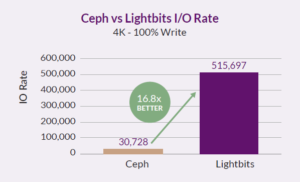Organizations from a wide range of industries are building their own on-premises, private clouds with software-defined storage emerging as the preferred solution. Open-source Ceph Storage is frequently considered. But where high performance at scale is required, Ceph Storage often shows significant limitations. That’s where data storage solutions from Lightbits come in as the ideal Ceph Storage alternative.
FIVE WAYS LIGHTBITS IS BETTER THAN CEPH STORAGE
-
HIGH PERFORMANCE DATA STORAGE THAT SCALES
 Lightbits block storage demonstrates 16x better IOPS and significantly higher throughput than Ceph across various workloads, scaling beyond the petabyte level and delivering up to 75 million IOPS and consistent sub-millisecond latency even under a heavy load. This exceptional performance profile ensures optimal responsiveness for cloud-native applications, enhancing overall user experience and productivity. Architected to leverage the benefits of NVMe storage, and built by the inventors of the NVMe® over TCP (NVMe/TCP) protocol, Lightbits delivers exceptional performance using standard TCP/IP networks and Ethernet NICs without requiring any configuration changes. No proprietary software is installed on client systems.
Lightbits block storage demonstrates 16x better IOPS and significantly higher throughput than Ceph across various workloads, scaling beyond the petabyte level and delivering up to 75 million IOPS and consistent sub-millisecond latency even under a heavy load. This exceptional performance profile ensures optimal responsiveness for cloud-native applications, enhancing overall user experience and productivity. Architected to leverage the benefits of NVMe storage, and built by the inventors of the NVMe® over TCP (NVMe/TCP) protocol, Lightbits delivers exceptional performance using standard TCP/IP networks and Ethernet NICs without requiring any configuration changes. No proprietary software is installed on client systems. -
COST EFFICIENT AND LOWER TCO
Leveraging Lightbits’ distributed block storage architecture, enterprises can achieve higher performance with fewer resources scaling their storage infrastructure seamlessly as their needs evolve. By requiring fewer servers and storage media compared to Ceph Storage, Lightbits significantly reduces infrastructure costs, maximizing return on investment while maintaining top-tier performance. Where application servers with local NVMe storage are often 15-25% utilized, Lightbits data storage solutions allow you to scale performance and capacity independently and dynamically to maximize utilization.
-
HIGHLY AVAILABLE FOR ENHANCED RESILIENCY
Lightbits’ clustered architecture eliminates service disruptions if nodes or drives fail or become inaccessible, heals itself when nodes or drives are replaced, and supports non-disruptive rolling software upgrades. Intelligent flash management and erasure coding techniques provide robust data protection and high availability. Unlike Ceph’s replication approach, Lightbits’ erasure coding ensures data availability even in the event of multiple drive failures, minimizing downtime and ensuring uninterrupted operations. Multi-zone synchronous replication across racks or data centers provides resiliency for business continuity.
-
SEAMLESSLY INTEGRATED WITH CLOUD-NATIVE STORAGE ENVIRONMENTS
Designed from the ground up for cloud-native storage environments, Lightbits persistent storage is an ideal Kubernetes storage solution that seamlessly integrates with cloud-based applications. Its compatibility with NVMe/TCP and Kubernetes Container Storage Interface ensures easy deployment and management within modern cloud infrastructures, simplifying operations and accelerating time to market. A single Lightbits cluster can support hundreds of Kubernetes clusters.
-
ESSENTIAL DATA SERVICES THAT REDUCE RISK
For mixed workloads and multiple heterogeneous environments, Lightbits software-defined storage enables multi-tenancy with Quality-of-Service capabilities to prevent “noisy neighbor” resource hogging. Data protection and persistent volumes are delivered via space-efficient snapshots and clones with near-instant restores. Enable DevOps to innovate at the speed of NVMe by cloning multi-terabyte databases nearly instantaneously. Developers are able to apply, test, and validate changes using minimal storage capacity and without disrupting production systems. All these data services are available at no additional cost.
Further your learning with the white paper, “Run Apps up to 16X Faster: Storage Performance Comparison Lightbits vs. Ceph Storage.”

